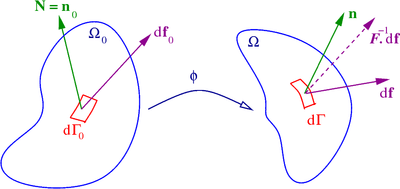Continuum mechanics/Stress measures
< Continuum mechanicsStress measures
Three stress measures are widely used in continuum mechanics (particularly in the computational context). These are
- The Cauchy stress (
 ) or true stress.
) or true stress. - The Nominal stress (
 ) (which is the transpose of the first Piola-Kirchhoff stress (
) (which is the transpose of the first Piola-Kirchhoff stress ( ).
). - The second Piola-Kirchhoff stress or PK2 stress (
 ).
).
Consider the situation shown the following figure.
 Quantities used in the definition of stress measures |
The following definitions use the information in the figure. In the reference configuration  , the outward normal to a surface element
, the outward normal to a surface element  is
is  and the traction acting on that surface is
and the traction acting on that surface is  leading to a force vector
leading to a force vector  . In the deformed configuration
. In the deformed configuration  , the surface element changes to
, the surface element changes to  with outward normal
with outward normal  and traction vector
and traction vector  leading to a force
leading to a force  . Note that this surface can either be a hypothetical cut inside the body or an actual surface.
. Note that this surface can either be a hypothetical cut inside the body or an actual surface.
Cauchy stress
The Cauchy stress (or true stress) is a measure of the force acting on an element of area in the deformed configuration. This tensor is symmetric and is defined via
or
where  is the traction and
is the traction and  is the normal to the surface on which the traction acts.
is the normal to the surface on which the traction acts.
Nominal stress/First Piola-Kirchhoff stress
The nominal stress ( ) is the transpose of the first Piola-Kirchhoff stress (PK1 stress) (
) is the transpose of the first Piola-Kirchhoff stress (PK1 stress) ( ) and is defined via
) and is defined via
or
This stress is unsymmetric and is a two point tensor like the deformation gradient. This is because it relates the force in the deformed configuration to an oriented area vector in the reference configuration.
2nd Piola Kirchhoff stress
If we pull back  to the reference configuration, we have
to the reference configuration, we have
or,
The PK2 stress ( ) is symmetric and is defined via the relation
) is symmetric and is defined via the relation
Therefore,
Relations between Cauchy stress and nominal stress
Recall Nanson's formula relating areas in the reference and deformed configurations:
Now,
Hence,
or,
or,
In index notation,
Therefore,
The quantity  is called the Kirchhoff stress tensor and is used widely in numerical algorithms in metal plasticity (where there
is no change in volume during plastic deformation).
is called the Kirchhoff stress tensor and is used widely in numerical algorithms in metal plasticity (where there
is no change in volume during plastic deformation).
Note that  and
and  are not symmetric because
are not symmetric because  is not symmetric.
is not symmetric.
Relations between nominal stress and second P-K stress
Recall that
and
Therefore,
or (using the symmetry of  ),
),
In index notation,
Alternatively, we can write
Relations between Cauchy stress and second P-K stress
Recall that
In terms of the 2nd PK stress, we have
Therefore,
In index notation,
Since the Cauchy stress (and hence the Kirchhoff stress) is symmetric, the 2n PK stress is also symmetric.
Alternatively, we can write
or,
Clearly, from definition of the push-forward and pull-back operations, we have
and
Therefore,  is the pull back of
is the pull back of  by
by  and
and  is the push forward of
is the push forward of  .
.



























![\boldsymbol{S} = \varphi^{*}[\boldsymbol{\tau}] = \boldsymbol{F}^{-1}\cdot\boldsymbol{\tau}\cdot\boldsymbol{F}^{-T}](../I/m/7b8c6d0ad8ab42b6459ca397ee04cd6f.png)
![\boldsymbol{\tau} = \varphi_{*}[\boldsymbol{S}] = \boldsymbol{F}\cdot\boldsymbol{S}\cdot\boldsymbol{F}^T~.](../I/m/b156b1ac60308eb873458952b4bb333f.png)